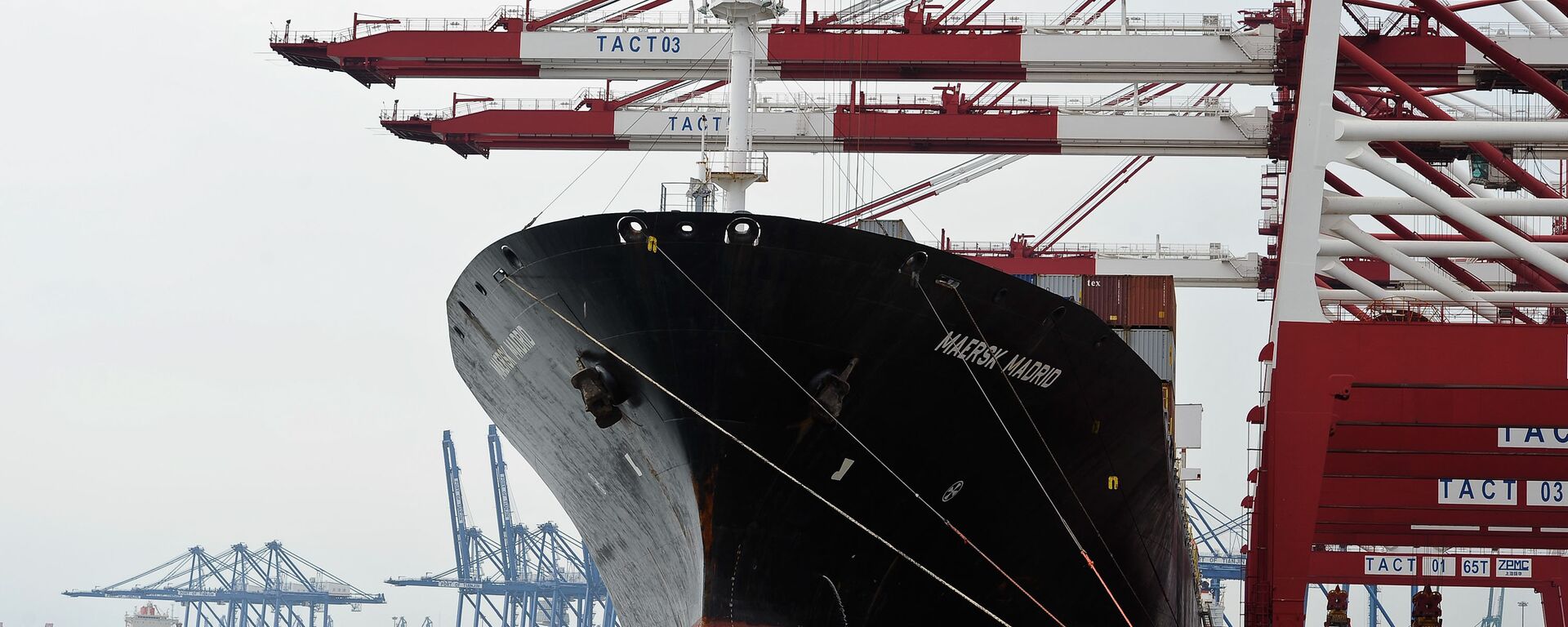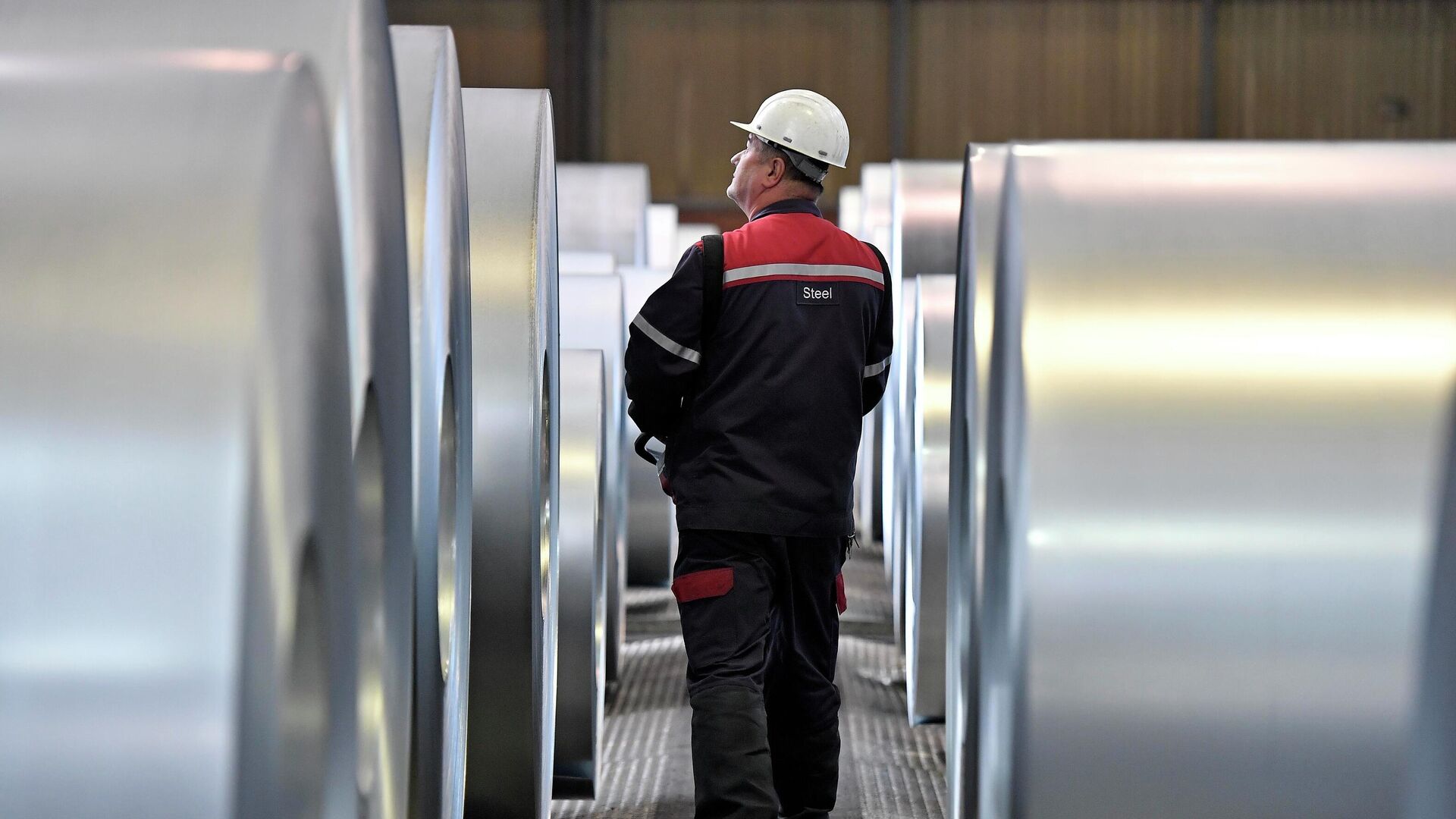https://sputnikglobe.com/20230802/us-and-eu-struggle-to-resolve-steel-and-aluminum-trade-dispute-as-deadline-looms-1112352722.html
US and EU Struggle to Resolve Steel and Aluminum Trade Dispute as Deadline Looms
US and EU Struggle to Resolve Steel and Aluminum Trade Dispute as Deadline Looms
Sputnik International
Struggle to find common ground in the pursuit of a Global Arrangement on Sustainable Steel and Aluminum, facing obstacles in resolving oversupply and carbon pricing disputes as tensions rise as crucial talks intensify amidst growing concerns over China's role in the trade conundrum
2023-08-02T18:46+0000
2023-08-02T18:46+0000
2023-12-08T11:26+0000
world
joe biden
donald trump
ursula von der leyen
china
european union (eu)
gsa
european commission
https://cdn1.img.sputnikglobe.com/img/07e6/07/05/1096982738_0:0:3153:1774_1920x0_80_0_0_e9791d1d076348c22f5afed8a3db52e8.jpg
It seems unlikely that the United States and European Union will reach a definitive agreement to control the steel and aluminum trade in 2023. They must decide whether to extend the October target date or reinstate tariffs on transatlantic exports worth billions of dollars.Recently, talks about the Global Arrangement on Sustainable Steel and Aluminum have become more intense, with significant strides towards addressing the issue of oversupply from nations like China, insider sources noted.Unless an agreement is reached by October 31, the tariffs implemented during former US President Donald Trump's administration, mirrored by the EU, will revert quickly to impact exports worth over $10 billion unless the current agreement is extended.GSA ConundrumThe Global Steel Agreement (GSA) is trying to resolve a standoff that began in 2018. Back then, Trump imposed tariffs on European steel and aluminum exports, claiming they threatened national security. In 2021, the US and EU suspended the repressive actions to resolve the dispute.US and EU officials are working together to turn their progress on non-market excess capacity (a central part of the GSA) into written words, a source familiar with the matter affirms. The objective is to organize a summit by fall between US President Joe Biden and European Commission President Ursula von der Leyen.Despite the insistence from both parties that Oct. 31 is a strict timeline, if they achieve significant results in reducing overcapacity, the talks might continue beyond that date without imposing tariffs, some sources stated on conditions of anonymity because of the confidentiality of the negotiations.The GSA is a potential long-term solution to fix steel and aluminum trade disputes. The US has offered joint tariffs targeting steel production by pumping carbon into the atmosphere and global high supply volume while providing inequitable access to countries meeting its standards.Official Positions of Concern of PartiesThe mouthpiece for the US Trade Representative's office expressed that they are still working hard to reduce carbon emissions in the steel and aluminum industries and deal with overproduction by the end of October. The European Commission's spokesperson also mentioned that the EU and US are determined to reach a successful agreement on the GSA and are actively discussing details. However, both sides admit that the negotiations have yet to achieve a significant milestone.On Tuesday, in a meeting between Wang Jiangping, the vice minister of China's Ministry of Industry and Information Technology, and the CEO of Brazilian mining firm Vale SA, the Chinese vice minister expressed that China's steel industry has been improving its supply chain structure to address the market glut.US Trade Representative Katherine Tai suggested forming a league of nations for tariff hikes on steel and aluminum imports produced with a high carbon footprint, mainly targeting China. The haste to reach a deal and avoid tariff escalation is intensified by the upcoming EU parliamentary elections in June and Biden’s re-election campaign in November next year.The US and EU have been in talks for months, with both sides expressing frustration. The Biden administration seeks exemption from the EU's carbon border levy and wants safeguards to reinstate tariffs on European exports under specific conditions. The EU urges to renegotiate the current respite, which it deems unfavorable.In the 2021 agreement, the United States imposed limits on the amount of steel and aluminum it imports from the European Union. The limit for steel is set at 3.3 million metric tons, and 384,000 tons for aluminum. Out of the total EU steel exports, which amounted to 670,000 tons, all faced a 25 percent tariff, while zero aluminum was hit with 10 percent.Carbon-Pricing BumpThe ongoing negotiations regarding the GSA are encountering obstacles concerning imposing taxes on imports from carbon-heavy industries. One key challenge is the need for a clear methodology within the US to establish domestic carbon emission pricing.Meanwhile, the EU’s concern is about potential violations of international trade regulations should they undertake collective action, as it already possesses in-house capabilities like a trading system and a carbon tariff mechanism. It insists on granting parties the autonomy to implement their blueprint for carbon pricing, but this approach may lead to disputes at the World Trade Organization (WTO).Both sides are investigating emissions intensity in their respective industries, which could eventually facilitate greater alignment of measures under the GSA. However, the final resolution may be delayed due to incomplete investigations by the fall.
https://sputnikglobe.com/20210217/china-passes-us-as-european-unions-largest-trading-partner-amid-historic-investment-agreement-1082098131.html
china
Sputnik International
feedback@sputniknews.com
+74956456601
MIA „Rosiya Segodnya“
2023
Chimauchem Nwosu
https://cdn1.img.sputnikglobe.com/img/07e7/09/01/1113046371_0:99:1536:1635_100x100_80_0_0_9c5c627283eca931c39fe4852bbb301c.jpg
Chimauchem Nwosu
https://cdn1.img.sputnikglobe.com/img/07e7/09/01/1113046371_0:99:1536:1635_100x100_80_0_0_9c5c627283eca931c39fe4852bbb301c.jpg
News
en_EN
Sputnik International
feedback@sputniknews.com
+74956456601
MIA „Rosiya Segodnya“
Sputnik International
feedback@sputniknews.com
+74956456601
MIA „Rosiya Segodnya“
Chimauchem Nwosu
https://cdn1.img.sputnikglobe.com/img/07e7/09/01/1113046371_0:99:1536:1635_100x100_80_0_0_9c5c627283eca931c39fe4852bbb301c.jpg
united states, european union, steel trade, aluminum trade, tariffs, global arrangement on sustainable steel and aluminum, oversupply, china, gsa conundrum, carbon emissions, trade dispute, biden, ursula von der leyen, negotiations, carbon border levy, eu parliamentary elections, biden's re-election campaign, carbon-heavy industries, international trade regulations, wto.
united states, european union, steel trade, aluminum trade, tariffs, global arrangement on sustainable steel and aluminum, oversupply, china, gsa conundrum, carbon emissions, trade dispute, biden, ursula von der leyen, negotiations, carbon border levy, eu parliamentary elections, biden's re-election campaign, carbon-heavy industries, international trade regulations, wto.
US and EU Struggle to Resolve Steel and Aluminum Trade Dispute as Deadline Looms
18:46 GMT 02.08.2023 (Updated: 11:26 GMT 08.12.2023) Brussels and Washington are struggling to find common ground in the pursuit of a Global Arrangement on Sustainable Steel and Aluminum, amid rising concerns over China's role in the trade conundrum.
It seems unlikely that the United States and European Union will reach a definitive agreement to control the steel and aluminum trade in 2023. They must decide whether to extend the October target date or reinstate tariffs on transatlantic exports worth billions of dollars.
Recently, talks about the Global Arrangement on Sustainable Steel and Aluminum have become more intense, with significant strides towards addressing the issue of oversupply from nations like China, insider sources noted.
Unless an agreement is reached by October 31, the tariffs implemented during former US President Donald Trump's administration, mirrored by the EU, will revert quickly to impact exports worth over $10 billion unless the current agreement is extended.
The Global Steel Agreement (GSA) is trying to resolve a standoff that began in 2018. Back then, Trump imposed tariffs on European steel and aluminum exports, claiming they threatened national security. In 2021, the US and EU suspended the repressive actions to resolve the dispute.
US and EU officials are working together to turn their progress on non-market excess capacity (a central part of the GSA) into written words, a source familiar with the matter affirms. The objective is to organize a summit by fall between US President
Joe Biden and European Commission President
Ursula von der Leyen.
Despite the insistence from both parties that Oct. 31 is a strict timeline, if they achieve significant results in reducing overcapacity, the talks might continue beyond that date without imposing tariffs, some sources stated on conditions of anonymity because of the confidentiality of the negotiations.
The GSA is a potential long-term solution to fix steel and aluminum trade disputes. The US has offered joint tariffs targeting steel production by pumping carbon into the atmosphere and global high supply volume while providing inequitable access to countries meeting its standards.
Official Positions of Concern of Parties
The mouthpiece for the US Trade Representative's office expressed that they are still working hard to reduce carbon emissions in the steel and aluminum industries and deal with overproduction by the end of October. The European Commission's spokesperson also mentioned that the EU and US are determined to reach a successful agreement on the GSA and are actively discussing details. However, both sides admit that the negotiations have yet to achieve a significant milestone.

17 February 2021, 00:35 GMT
On Tuesday, in a meeting between Wang Jiangping, the vice minister of China's Ministry of Industry and Information Technology, and the CEO of Brazilian mining firm Vale SA, the Chinese vice minister expressed that China's steel industry has been improving its supply chain structure to address the market glut.
US Trade Representative Katherine Tai suggested forming a league of nations for tariff hikes on steel and aluminum imports produced with a high carbon footprint, mainly targeting China. The haste to reach a deal and avoid tariff escalation is intensified by the upcoming EU parliamentary elections in June and Biden’s re-election campaign in November next year.
The US and EU have been in talks for months, with both sides expressing frustration. The Biden administration seeks exemption from the EU's carbon border levy and wants safeguards to reinstate tariffs on European exports under specific conditions. The EU urges to renegotiate the current respite, which it deems unfavorable.
In the 2021 agreement, the United States imposed limits on the amount of steel and aluminum it imports from the European Union. The limit for steel is set at 3.3 million metric tons, and 384,000 tons for aluminum. Out of the total EU steel exports, which amounted to 670,000 tons, all faced a 25 percent tariff, while zero aluminum was hit with 10 percent.
The ongoing negotiations regarding the GSA are encountering obstacles concerning imposing taxes on imports from carbon-heavy industries. One key challenge is the need for a clear methodology within the US to establish domestic carbon emission pricing.
Meanwhile, the EU’s concern is about potential violations of international trade regulations should they undertake collective action, as it already possesses in-house capabilities like a trading system and a carbon tariff mechanism. It insists on granting parties the autonomy to implement their blueprint for carbon pricing, but this approach may lead to disputes at the World Trade Organization (WTO).
Both sides are investigating emissions intensity in their respective industries, which could eventually facilitate greater alignment of measures under the GSA. However, the final resolution may be delayed due to incomplete investigations by the fall.






